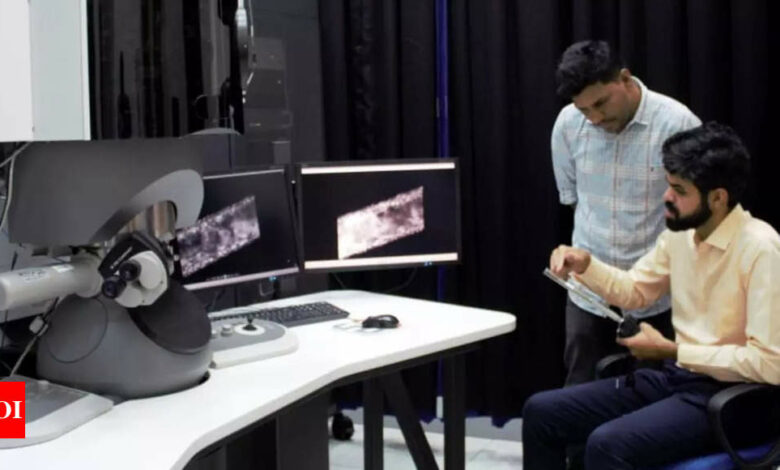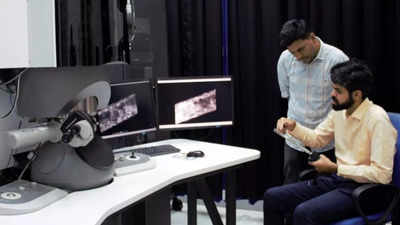India
Self-shock turns crystal into glass at ultra-low power density: research | India News – Times of India



Pavan Nukala (right) with Pradeep Kumar (left), responsible for the electron microscope facility at CeNSE. Images of distorted nanowires are projected onto the screen
In groundbreaking collaborative work published today in Nature, researchers show that a material called indium selenide can “shock” itself to transform from a crystalline to a glassy phase at very low power.
“This transformation is at the heart of memory storage in devices such as CDs and computer RAMs. It uses a billion times less energy than the traditional melt-quench process used to convert crystal into glass,” said IISc.
Researchers point out that glasses behave like solids, but lack the typical periodic arrangement of atoms. They said that during glass making, a crystal is liquefied (melted) and then suddenly cooled (quenched) to prevent the glass from becoming too organized.
“…This melt-quenching process is also used in CDs, DVDs and Blu-ray discs – laser pulses are used to heat and quench a crystalline material very quickly into the glassy phase to write data; Reversing the process may erase data. Computers use similar materials, called phase change RAMs, which store information based on the type of resistance – high versus low – offered by the glassy and crystalline states,” IISc said.
The problem, however, is that these devices consume a lot of power, especially during the writing process. The crystals must be heated to temperatures above 800oC and cooled suddenly. If there is a way to convert the crystal directly to glass without the intermediate liquid phase, the power required for memory storage can be significantly reduced.
In the study, the team found that when electric current was passed through wires made of indium selenide, a 2D ferroelectric material, large chunks of material suddenly amorphized into glass.
“This was extremely unusual. I actually thought I might have damaged the material. Normally you would need electrical pulses to induce any kind of amorphization, and here a continuous current would have disrupted the crystalline structure, which should not have happened,” says Gaurav Modi, a former PhD candidate at Penn Engineering and one of the first authors . .
Modi and Ritesh Agarwal, a Srinivasa Ramanujan Distinguished Scholar in Materials Science and Engineering (MSE) at Penn Engineering, collaborated with Pavan Nukala, assistant professor at the Center for Nano Science and Engineering (CeNSE), IISc and his PhD student Shubham Parate to follow this process closely – from atomic to micrometer length scales – under an electron microscope.
“Over the past few years we have developed a range of in situ microscopy instruments here at IISc. When Ritesh told me about this unusual observation, we decided it was time to put these tools to the test,” Nukala explains.
What the team discovered was that when a continuous current is passed parallel to the 2D layers of the material, the layers slide against each other in different directions. This causes the formation of many domains – small pockets with a specific dipole moment – bound by defect regions that separate the domains. When multiple defects intersect in a small nanoscopic area, such as too many holes in a wall, the structural integrity of the crystal collapses and glass forms locally.
These domain boundaries are like tectonic plates. They move with the electric field, and when they collide, mechanical (and electrical) shocks are generated, similar to an earthquake. This earthquake causes an avalanche effect, causing disturbances far away from the epicenter, creating more domain boundaries and resulting glassy areas, which in turn cause more earthquakes. The avalanche stops when the entire material turns into glass (long-range amorphization).
“It’s just goosebumps to see all these factors come to life and play together, at different length scales in an electron microscope,” says Parate, one of the first authors.
Nukala points out that several unique properties of indium selenide – its 2D structure, ferroelectricity and piezoelectricity – all come together to enable this ultra-low energy pathway for shock amorphization. “We are going to take this to the next level by integrating these devices on CMOS platforms,” he adds.
“One of the reasons why PCM (phase-change memory) devices are not yet widely used is the energy required,” says Agarwal. Such advances could unlock a wider range of PCM applications that could transform data storage on devices from mobile phones to computers.




